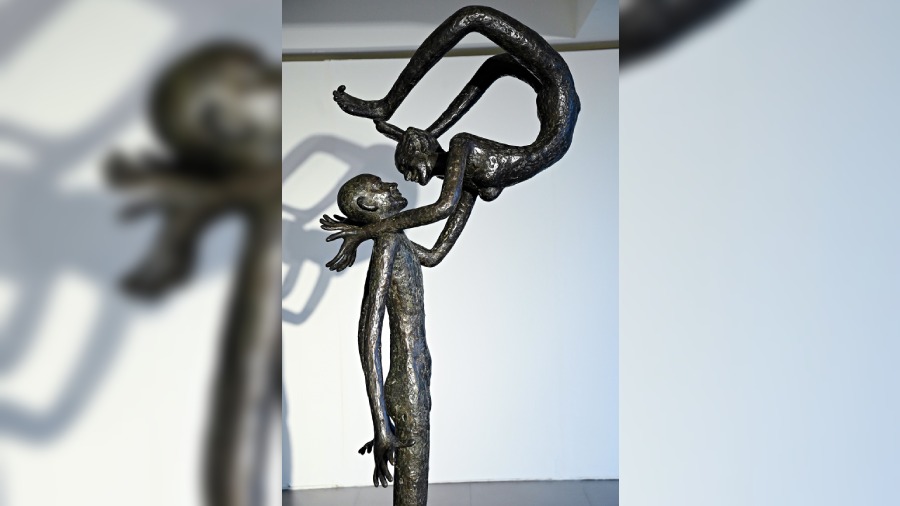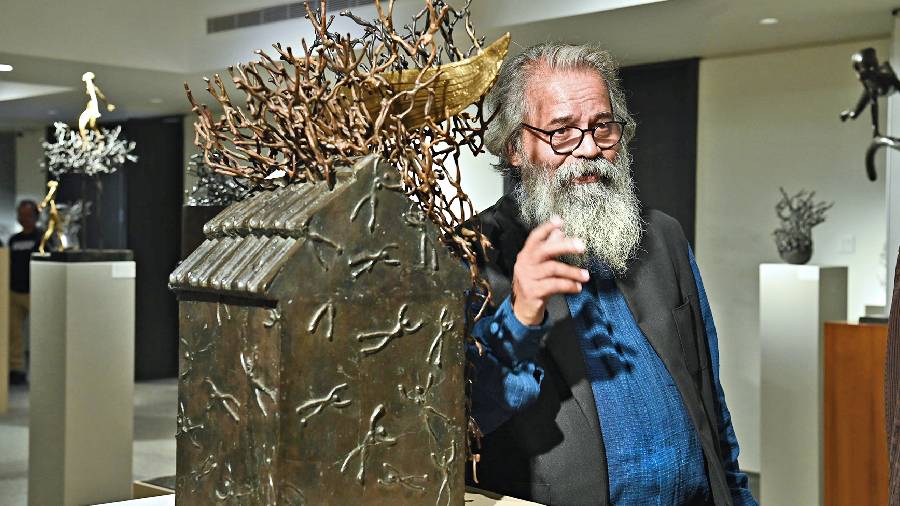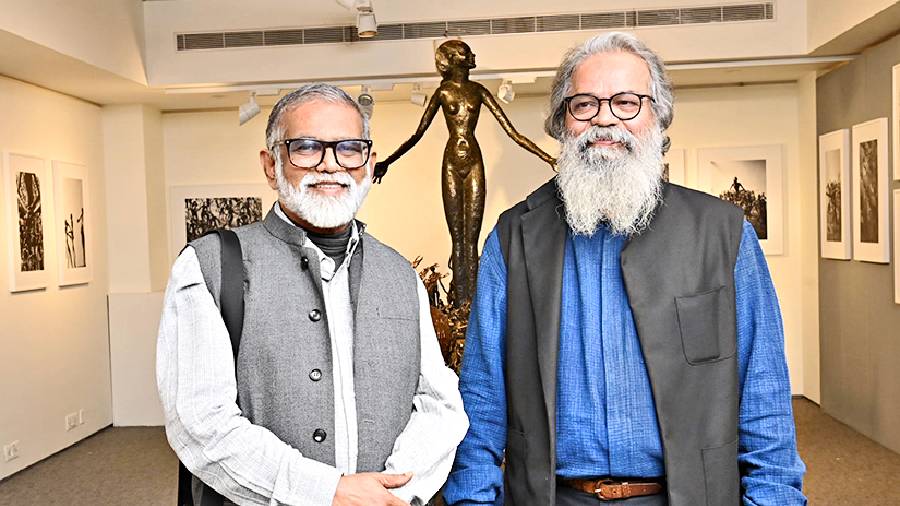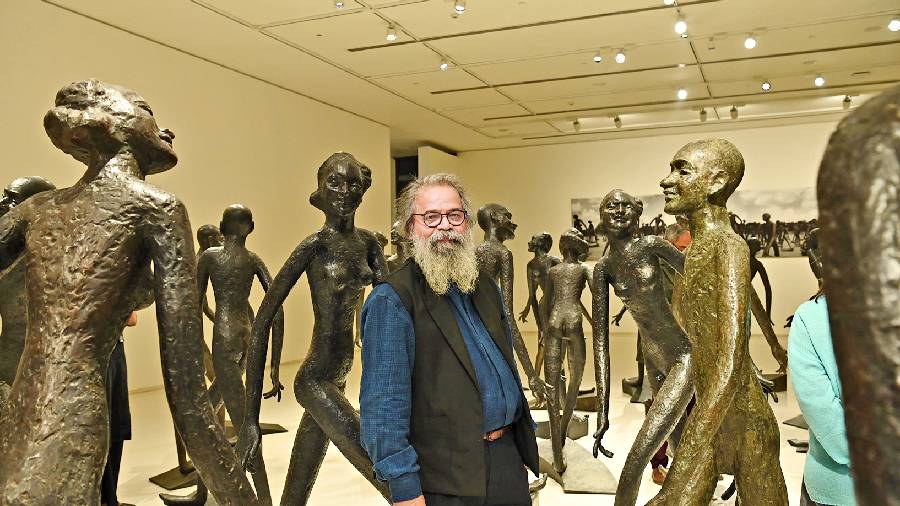K.S. Radhakrishnan and his sculpted muses Musui and Maiya are back in Kolkata after a gap of 15 years and his recent exhibition 'The Crowd and Its Avatars' connects the individual to the social and real to the imaginary. Stationed at Emami Art till February 12, and curated by R Siva Kumar, Musui, and Maiya and its different avatars are not just bronze sculptures, they have the power to take the viewer in their fold and make them a part of their world. “My work is not narrative but tries to depict the essence of the event or thought. And along with the work, I wish to inspire or provoke a thinking space around it. Through these figures, I hope to make the viewers think: what is this subject doing, what is happening in its world, and what is going on internally? I am not presenting an answer, instead, I am posing questions. I am keen that my work should engage with people and don’t charge money for public installations,” said Radhakrishnan who has studios in Delhi and Santiniketan and for whom Kolkata is his second home.
“For people of my generation, Kolkata has always been the cultural capital. There is a large and supportive audience here, with many trained eyes to engage with the work. Ideally, I want to show my work first in Kolkata, before travelling elsewhere with it,” said the Kerala-born artist who has also included compelling black-and-white photographs by legendary photographer Prabuddha Dasgupta. Excerpts from an interview:
Q What is it about the human form that attracts you as an artist?
I see the human and the potential of the human in all kinds of things —even in rising smoke. Humanity is my fundamental interest; humanism is what I live by and create art by. Human desires, aspirations, celebration, reaching out, being fulfilled, wanting more…I feel great sympathy with these ceaseless themes of the human experience. In particular, for human beings’ efforts to reach out towards the light.
As an introverted student, my work used to be in dialogue with myself. I was interested in capturing movement without bodies. But human figures soon became my subjects, helping me respond to the whole human as well as socio-political drama happening around me. No other form spoke to me as the human did.
Q What’s the genesis of Musui and Maiya and how have they evolved over the years?
In 1977 in Santiniketan, I met a Santhal boy called Musui on the road, asking me for food. His beautiful face and body appeared as if he had no muscles or bones. He had a sublime smile. I made a big nude sculpture of his but, unable to transport it to Delhi, broke off the head and took it with me. The face of that guileless young man became my symbol of the human. In 1996, I created my first Musui as a smiling rickshaw puller. Over the years, Musui has been a devil, an imp, a saint, the Natraj… and so much else. I felt the need for a counterpart for him, to complete his narrative, so I added a female body to the Musui face. And Maiya-Musui became a whole. I see many Musui and Maiyas in the world; my sculpture addresses them. They take on different personas and roles in the world, they are bahuroopis, sometimes just to survive in life, sometimes to protect their inner selves, and sometimes to reach some goal.
In 'The Crowd', which has 25 Musuis and 25 Maiyas, the faces are the same — the essential humanity is the same — but the movements are different, and the body language is different. Each has his/her own individual trajectory.
Q At the exhibition, we see Musui and Maiya in a static yet moving form on the ground floor and then in more animated forms on the fourth floor. Tell us about the idea behind it.
We, humans, are made as much of thoughts and ideas, feelings and memories, stories and emotions, as we are of flesh and blood. The pieces in this exhibition were created over the last two decades to capture this essence of ours. These works explore the varied aspects of human existence. In all these pieces, tiny figures are coming together to invoke the ephemeral — heat, steam, light, thoughts, memories… These tiny figures were inspired by the many many people whom I witnessed coming to build their homes in the area of Chhatarpur Pahadi in Delhi, where I had made my studio in the 1990s. Many of the pieces look back with intense nostalgia at my childhood memories of rural Kerala — they pay a tribute to the daily objects and experiences that I took for granted then, and the memories which I cherish now. The metal bucket, pots and pans, incense burners, idli maker, clothes iron, and angithi, have all contributed to making me who I am.

K.S. Radhakrishnan’s Musui and Maiya
Q Unlike some art, 'The Crowd' is not just for the eyes but invites one to be a part of it. Tell us about this aspect of your art.
Not just the viewers, but I too am invited to be a part of 'The Crowd'! Even when I stood with the first 10 of these figures, I could see how I became the 11th. With 'The Crowd', I feel I am not showing work, I am experiencing it. I am uncomfortable in crowds and have always resisted being a part of them. There is a great relief when a crowd dissolves. Like the opening of a knot. I enjoy the idea of the viewer becoming part of the sculpture!

K.S. Radhakrishnan with one of his exhibits at Emami Art
Q Your main medium is bronze. What is it about it that connects with you?
My teacher and mentor, the sculptor Sarbari Roy Choudhury introduced bronze sculpting in Kala Bhavana. I find the medium very satisfying. People ask me why I am still working with this traditional medium, as opposed to, say, fiberglass, but traditional material does not mean you cannot be contemporary, or belong to and respond to your times. After all, you can also be very traditional while using a very modern material. The strength of bronze helps Musui and Maiya express their transcendental selves —unhampered by gravity. Even when Maiya becomes a writer, she can do with just her fingers close to the writing surface while the rest of her body floats upwards, confident that it will be supported by the medium.
Bronze usually evokes big and solid pieces and this has been true of my work as well. But in the small pieces on the fourth floor in this exhibition, I have found it very exciting to break that paradigm and work with these very small, apparently weightless pieces to create insubstantial presences like smoke or aroma.

K.S. Radhakrishnan with curator R. Siva Kumar
Q. The exhibition also includes Prabuddha Dasgupta’s photographs. Tell us about your association with him and how they add a new dimension to your work.
Prabuddha Dasgupta was not only my close friend, but he was also one of the best viewers I had for my work. Through his photographs, he showed me aspects of my sculpture that had remained unseen even to my eyes.
We met in Santiniketan in 1977, where his father, the sculptorPradosh Dasgupta, taught as a visiting professor. Our friendship deepened when I shifted to Delhi in the early 1980s when Prabuddhawas a copywriter. We explored the city, watched films, listened to music, and chatted through the night…. When he showed me his early photographs, I loved one so much that I gave him Rs 500 for it. So I became the first buyer of a Prabuddha Dasgupta print! (Then I made him buy a frame using half that money!)
He never photographed the work of any other artist but he made many images of my work, including pieces in progress. He shot extensively in my studio. In 1990, when we were in Paris, he placed several of my sculptures out in the fields of Nemours for making open-air images.
So, here I have shown my sculpture 'The Ramp' accompanied by Prabuddha’s photos of the same work. He photographed it from unexpected angles, such as bird’s-eye images taken from a floor above.
Prabuddha is legendary as the man who reinvented commercial photography in India but for me, he was my friend Gulu. He passed away unexpectedly in 2012. This part of the exhibition is, perhaps, a simultaneous celebration and mourning if such a thing is possible.

One of the art installations of K.S. Radhakrishnan
Q. Now that the world has opened where are you taking your exhibition next?
The exhibition will go next to Bikaner House in Delhi before the end of this year and will go to Ahmedabad in 2024.
